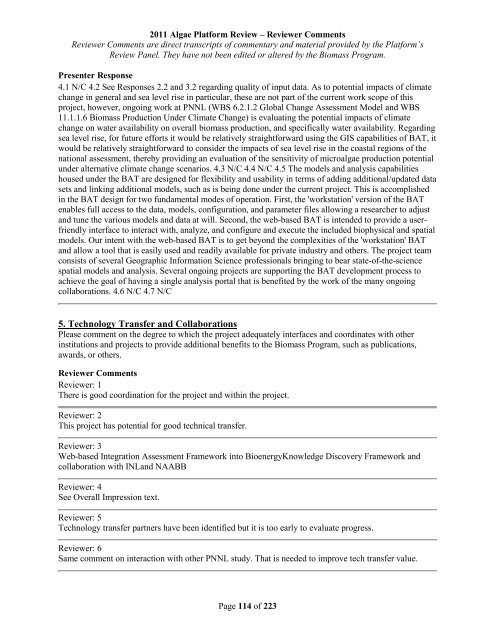Reviewer Comments - EERE
Reviewer Comments - EERE
Reviewer Comments - EERE
You also want an ePaper? Increase the reach of your titles
YUMPU automatically turns print PDFs into web optimized ePapers that Google loves.
2011 Algae Platform Review – <strong>Reviewer</strong> <strong>Comments</strong><br />
<strong>Reviewer</strong> <strong>Comments</strong> are direct transcripts of commentary and material provided by the Platform’s<br />
Review Panel. They have not been edited or altered by the Biomass Program.<br />
Presenter Response<br />
4.1 N/C 4.2 See Responses 2.2 and 3.2 regarding quality of input data. As to potential impacts of climate<br />
change in general and sea level rise in particular, these are not part of the current work scope of this<br />
project, however, ongoing work at PNNL (WBS 6.2.1.2 Global Change Assessment Model and WBS<br />
11.1.1.6 Biomass Production Under Climate Change) is evaluating the potential impacts of climate<br />
change on water availability on overall biomass production, and specifically water availability. Regarding<br />
sea level rise, for future efforts it would be relatively straightforward using the GIS capabilities of BAT, it<br />
would be relatively straightforward to consider the impacts of sea level rise in the coastal regions of the<br />
national assessment, thereby providing an evaluation of the sensitivity of microalgae production potential<br />
under alternative climate change scenarios. 4.3 N/C 4.4 N/C 4.5 The models and analysis capabilities<br />
housed under the BAT are designed for flexibility and usability in terms of adding additional/updated data<br />
sets and linking additional models, such as is being done under the current project. This is accomplished<br />
in the BAT design for two fundamental modes of operation. First, the 'workstation' version of the BAT<br />
enables full access to the data, models, configuration, and parameter files allowing a researcher to adjust<br />
and tune the various models and data at will. Second, the web-based BAT is intended to provide a userfriendly<br />
interface to interact with, analyze, and configure and execute the included biophysical and spatial<br />
models. Our intent with the web-based BAT is to get beyond the complexities of the 'workstation' BAT<br />
and allow a tool that is easily used and readily available for private industry and others. The project team<br />
consists of several Geographic Information Science professionals bringing to bear state-of-the-science<br />
spatial models and analysis. Several ongoing projects are supporting the BAT development process to<br />
achieve the goal of having a single analysis portal that is benefited by the work of the many ongoing<br />
collaborations. 4.6 N/C 4.7 N/C<br />
5. Technology Transfer and Collaborations<br />
Please comment on the degree to which the project adequately interfaces and coordinates with other<br />
institutions and projects to provide additional benefits to the Biomass Program, such as publications,<br />
awards, or others.<br />
<strong>Reviewer</strong> <strong>Comments</strong><br />
<strong>Reviewer</strong>: 1<br />
There is good coordination for the project and within the project.<br />
<strong>Reviewer</strong>: 2<br />
This project has potential for good technical transfer.<br />
<strong>Reviewer</strong>: 3<br />
Web-based Integration Assessment Framework into BioenergyKnowledge Discovery Framework and<br />
collaboration with INLand NAABB<br />
<strong>Reviewer</strong>: 4<br />
See Overall Impression text.<br />
<strong>Reviewer</strong>: 5<br />
Technology transfer partners have been identified but it is too early to evaluate progress.<br />
<strong>Reviewer</strong>: 6<br />
Same comment on interaction with other PNNL study. That is needed to improve tech transfer value.<br />
Page 114 of 223




